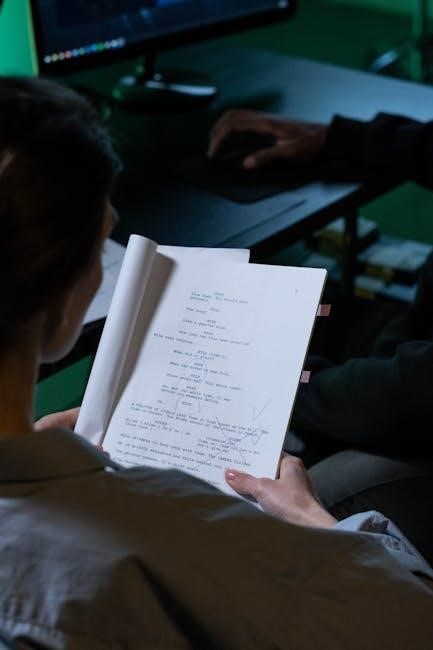Agatha Christie’s “Murder on the Orient Express” stands as a cornerstone of detective fiction․ The novel follows Hercule Poirot, a brilliant Belgian detective, on a thrilling journey aboard the luxurious Orient Express․
When a wealthy passenger is found murdered, Poirot embarks on a meticulous investigation․ The train, trapped by snow, becomes a confined stage for Poirot’s deductive prowess, unraveling secrets and exposing hidden motives․
Agatha Christie’s “Murder on the Orient Express” is a timeless masterpiece of mystery and suspense, solidifying her reputation as the “Queen of Crime․” Published in 1934, the novel showcases Christie’s ingenious plotting and character development, captivating readers for generations․ The story unfolds on the opulent Orient Express, a symbol of luxury and intrigue, where a diverse group of passengers becomes entangled in a web of secrets and suspicion․
At the heart of the narrative lies the enigmatic detective Hercule Poirot, renowned for his sharp intellect and unwavering commitment to justice․ When a wealthy American tycoon is found murdered in his locked compartment, Poirot is tasked with unraveling the truth behind the crime․ As the train is halted by a snowdrift in the remote Balkan countryside, Poirot must navigate a labyrinth of clues, alibis, and hidden connections to unmask the killer lurking among the passengers․ The novel’s enduring appeal lies in its intricate plot, compelling characters, and the clever resolution of the mystery, leaving readers guessing until the very end․
Overview of “Murder on the Orient Express”
Agatha Christie’s Classic Detective Novel
Hercule Poirot’s Investigation
Hercule Poirot, the meticulous and observant Belgian detective, finds himself embroiled in a perplexing murder case aboard the luxurious Orient Express․ His investigation begins when Samuel Ratchett, a wealthy and unsavory American passenger, is discovered dead in his compartment, the victim of a brutal stabbing․ With the train stranded by a snowdrift in the remote mountains, Poirot is confined with a limited pool of suspects, each harboring secrets and potential motives․
Poirot’s methodical approach involves careful observation, detailed questioning, and the meticulous examination of every clue․ He interviews each passenger, probing their alibis, uncovering their connections to the victim, and scrutinizing their behavior for any sign of deception․ As Poirot delves deeper into the investigation, he uncovers a complex web of relationships and hidden identities, revealing that Ratchett was not who he seemed to be․ Poirot must sift through the lies and half-truths to expose the killer and deliver justice․

Plot Summary
Samuel Ratchett is found murdered on the Orient Express, prompting Hercule Poirot to investigate․ The train is snowbound, trapping all passengers, each with secrets and potential motives for the crime․
Murder of Samuel Ratchett
The narrative of “Murder on the Orient Express” ignites with the shocking demise of Samuel Ratchett, a wealthy American passenger, discovered lifeless within his locked compartment․ Ratchett, known for his repulsive character and shady past, becomes the focal point of Hercule Poirot’s intricate investigation․ The brutal nature of the crime, with Ratchett stabbed multiple times, hints at a deeply personal vendetta․ As Poirot delves deeper, he uncovers a web of hidden identities, interconnected pasts, and concealed motives among the train’s diverse occupants․
The confined setting of the snowbound Orient Express amplifies the tension, transforming the luxurious train into a claustrophobic stage for a deadly drama․ Each passenger falls under suspicion, their alibis scrutinized, and their connections to Ratchett examined․ Poirot’s keen observations and relentless pursuit of truth reveal a complex conspiracy, challenging the very notions of justice and morality․ The murder of Samuel Ratchett serves as the catalyst for a captivating journey into the dark recesses of human nature․
The Train Trapped by Snow
The opulent Orient Express, a symbol of luxury and sophistication, finds itself abruptly halted in its tracks, ensnared by a formidable snowdrift in the remote Balkan landscape․ This unforeseen obstruction transforms the train from a vessel of leisure into a confined arena, isolating its passengers from the outside world and intensifying the atmosphere of suspense․ The snowstorm becomes a crucial element in the narrative, effectively trapping the murderer alongside their potential victims, amplifying the urgency of Hercule Poirot’s investigation․
Communication with the outside world is severed, heightening the sense of vulnerability and dependence on Poirot’s ingenuity․ The passengers, a diverse assembly of nationalities and backgrounds, are forced to confront their secrets and suspicions within the limited confines of the train․ The immobility of the Orient Express underscores the themes of confinement and isolation, enhancing the psychological tension and contributing to the claustrophobic atmosphere that permeates the story․ The snow-induced halt becomes a symbolic representation of the frozen state of justice, awaiting Poirot’s discerning eye to thaw the truth․

Available Scripts
Numerous adaptations of “Murder on the Orient Express” exist, including film and stage versions․ These scripts offer unique interpretations of Agatha Christie’s classic, each with its own creative choices․
Film Adaptations
The allure of “Murder on the Orient Express” has led to several notable film adaptations, each bringing Agatha Christie’s intricate plot to the silver screen․ These adaptations often feature star-studded casts and attempt to capture the opulent setting and suspenseful atmosphere of the original novel․ Different screenwriters have interpreted the story, resulting in variations in pacing, character emphasis, and visual style․ Some adaptations hew closely to the source material, while others take liberties with the plot or characters to create a fresh cinematic experience․ Analyzing these film scripts reveals how filmmakers grapple with translating a complex, dialogue-driven mystery into a visually engaging format․ The availability of these scripts allows for comparative study, examining how different creative teams approach the same source material, and highlighting the challenges and opportunities inherent in adapting a beloved literary work for the screen․ Examining these scripts provides insight into the adaptation process․
1974 Film Script
The 1974 film adaptation of “Murder on the Orient Express” is a classic in its own right, boasting a stellar ensemble cast and a faithful rendition of Agatha Christie’s story․ The screenplay, penned by Paul Dehn, meticulously recreates the atmosphere of the luxurious train and the claustrophobic tension among the passengers․ Examining the 1974 film script reveals the choices made in translating Christie’s prose to a visual medium, including scene construction, dialogue adaptation, and character portrayal․ Comparisons to the original novel highlight the changes necessary to adapt the story for the screen, such as streamlining the plot or emphasizing certain characters․ The script offers insights into the pacing and suspense-building techniques employed by the filmmakers․ It also showcases how the scriptwriters handled the challenge of presenting a complex mystery with multiple suspects and red herrings․ Analyzing this script provides a valuable case study in adapting a beloved literary work for a cinematic audience, showcasing both the strengths and limitations of the adaptation process․
Stage Play Adaptations
The enduring popularity of “Murder on the Orient Express” has led to numerous stage play adaptations, each offering a unique interpretation of Agatha Christie’s intricate mystery․ These adaptations grapple with the challenge of translating the novel’s expansive setting and numerous characters to the confines of a stage․ Playwrights often employ creative staging techniques, such as minimalist sets and evocative lighting, to evoke the atmosphere of the Orient Express․ The adaptations frequently prioritize dialogue and character interaction, emphasizing the psychological tension among the suspects․ Different adaptations may choose to focus on particular aspects of the story, such as Poirot’s deductive process or the moral complexities of the crime․ Examining various stage play scripts reveals the diverse approaches taken to adapt the novel’s intricate plot for the stage․ Some adaptations may streamline the story, while others may introduce new elements or reinterpret existing ones․ Ultimately, stage play adaptations of “Murder on the Orient Express” offer a fresh perspective on a beloved classic, showcasing the story’s enduring appeal in a live theatrical setting․
Ken Ludwig’s Adaptation
Ken Ludwig’s adaptation of “Murder on the Orient Express” is a widely performed stage version known for its blend of suspense, humor, and theatrical flair․ Ludwig’s script skillfully condenses the novel’s complex plot and large cast of characters, creating a fast-paced and engaging theatrical experience․ His adaptation often emphasizes the comedic elements of the story, highlighting the quirky personalities of the passengers and Poirot’s eccentricities․ The dialogue is sharp and witty, adding a layer of levity to the otherwise dark and suspenseful narrative․ Ludwig’s adaptation maintains the core mystery of the novel while streamlining the plot for the stage, making it accessible to a wide audience․ Stage directions are detailed, providing guidance for directors and actors in bringing the story to life․ The script also includes opportunities for creative staging and design, allowing for visually stunning and memorable productions․ Ludwig’s adaptation is praised for its faithfulness to the spirit of the original novel while also offering a fresh and entertaining take on the classic mystery․ This version is a popular choice for theater companies seeking a crowd-pleasing and critically acclaimed production․

Characters
Hercule Poirot, the brilliant Belgian detective, is the central figure․ His keen observation skills and deductive reasoning drive the investigation, uncovering the secrets of the passengers and solving the intricate murder․
Hercule Poirot
Hercule Poirot, Agatha Christie’s iconic Belgian detective, is renowned for his exceptional intellect and meticulous methods․ He possesses a distinctive appearance, characterized by his perfectly groomed mustache and sharp attire․ Poirot’s profound understanding of human psychology enables him to unravel complex mysteries․
His fastidious nature and unwavering commitment to justice make him a formidable investigator․ Aboard the Orient Express, Poirot’s keen observation skills and “little grey cells” are put to the test as he navigates a web of deceit․ He approaches the case with a methodical approach, meticulously gathering clues and interviewing suspects․
Poirot’s ability to discern the truth from falsehoods is unparalleled․ He carefully analyzes the evidence, piecing together the puzzle to expose the culprit․ His dedication to justice ensures that the truth prevails, even in the most perplexing circumstances, making him the story’s moral compass․
Key Suspects
The Orient Express is populated by a diverse cast of characters, each harboring secrets and potential motives for Samuel Ratchett’s murder․ Among the key suspects is Hector MacQueen, Ratchett’s personal secretary, who displayed a clear animosity towards his employer․ Princess Dragomiroff, a Russian aristocrat, exudes an air of mystery and possesses a connection to the victim’s past;
Mary Debenham, a reserved governess, and Colonel Arbuthnot, a stoic military man, form an intriguing pair with a shared secret․ Hildegarde Schmidt, the German maid, appears unassuming but may hold vital information․ Count and Countess Andrenyi, a Hungarian couple, add to the international intrigue․
Each suspect presents a unique profile, making it challenging for Poirot to identify the true killer․ Their carefully constructed alibis and concealed connections create a complex web of deception․ Poirot must unravel their secrets to expose the murderer lurking among them, making the investigation a thrilling pursuit of truth․

Themes and Analysis
“Murder on the Orient Express” explores complex themes of justice and morality․ The narrative questions the nature of revenge and the justification of taking the law into one’s own hands within a closed society․
Justice and Morality
Agatha Christie’s “Murder on the Orient Express” delves into the intricate relationship between justice and morality․ The story presents a scenario where traditional legal avenues have failed, prompting a group of individuals to seek their own form of retribution․ This raises profound questions about the legitimacy of vigilante justice and the ethical boundaries of revenge․ The novel challenges the reader to consider whether the ends justify the means, particularly when the perpetrator has evaded legal consequences for a heinous crime․
Poirot, a staunch believer in due process, grapples with the moral implications of the collective act․ He is torn between his commitment to upholding the law and his understanding of the emotional motivations behind the crime․ The play forces the audience to confront uncomfortable truths about the fallibility of the justice system․ It also explores the seductive allure of taking matters into one’s own hands when faced with unbearable injustice․
Collaborative Storytelling
“Murder on the Orient Express” exemplifies collaborative storytelling through its intricate plot and ensemble cast․ The play showcases how multiple perspectives intertwine to create a complex narrative tapestry․ Each character holds a piece of the puzzle, contributing to the overarching mystery and ultimately revealing the truth․ The collaborative nature extends beyond the characters themselves, as the audience is invited to participate in the process of deduction․
As Poirot pieces together the clues, the audience becomes active participants in the investigation, analyzing the evidence and forming their own conclusions․ The play underscores the power of collective memory and shared experiences in shaping our understanding of events․ It also highlights the importance of diverse perspectives in uncovering the truth․ The script fosters a sense of shared responsibility in unraveling the mystery․